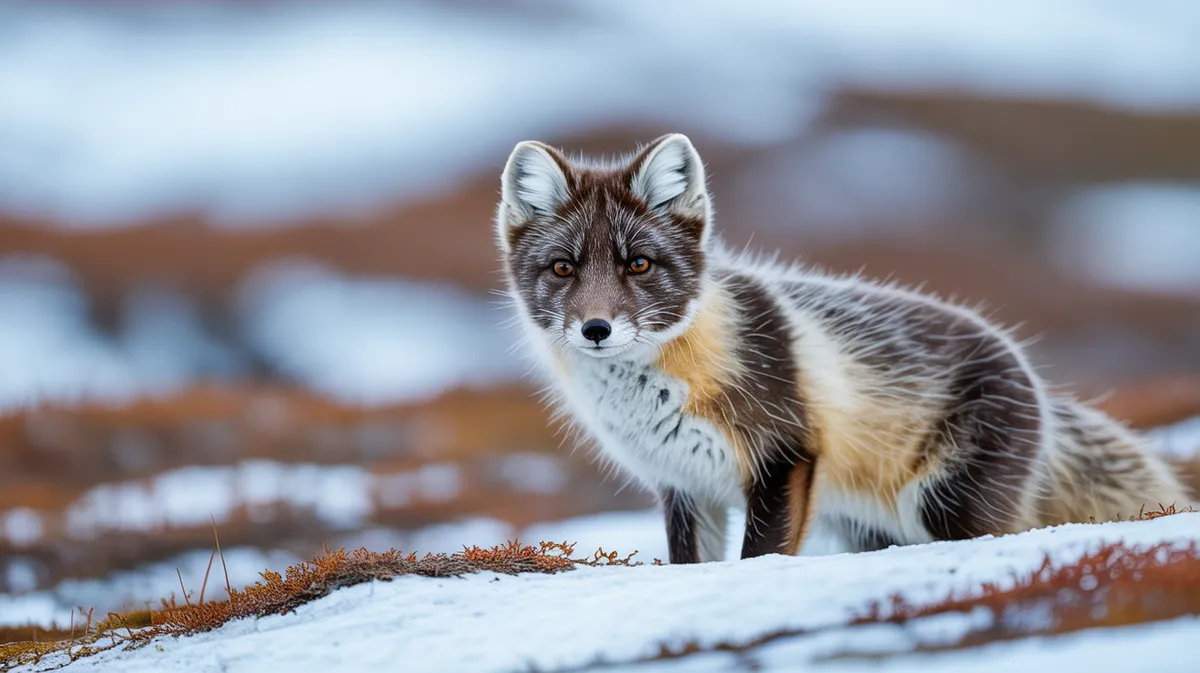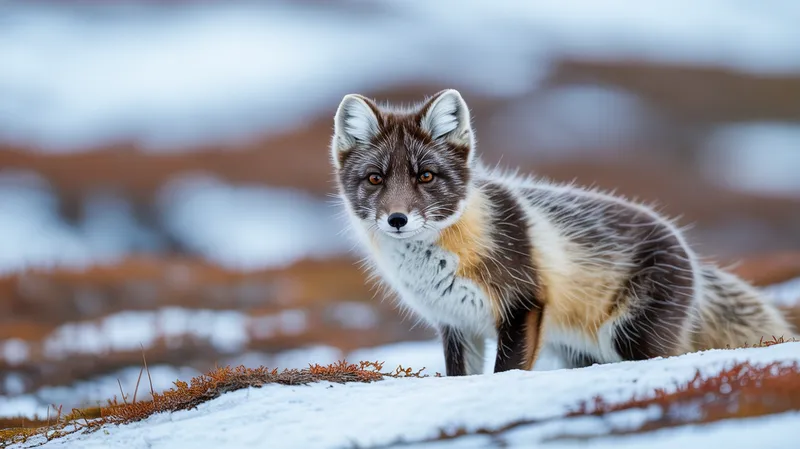
Arctic Fox
Vulpes lagopus

Meet the Arctic Fox
The Arctic Fox is a small, highly adapted mammal native to the Arctic regions of the Northern Hemisphere. It is renowned for its stunning white winter coat, which provides effective camouflage against the snow, and transitions to brown or gray during the summer months. The Arctic Fox is equipped with a compact body, short muzzle, and thick fur to conserve heat in harsh, freezing environments. It is a resourceful omnivore, capable of surviving on a wide variety of foods, and demonstrates remarkable endurance and adaptability in one of the planet's most extreme habitats.
Classification
Mammal
Habitat
Arctic tundra
Diet
Omnivore
Lifespan
3-6 years in the wild
Conservation
Least Concern
Weight
2.5–9 kg
📖Fascinating Facts
Seasonal Camouflage
The Arctic Fox's fur changes color with the seasons—white in winter to blend with snow, and brown or gray in summer to match the tundra landscape.
Survival Specialist
It has one of the warmest mammalian coats, with dense underfur and a bushy tail that it wraps around itself for extra warmth.
Diverse Diet
Besides hunting lemmings, Arctic Foxes eat birds, eggs, fish, berries, and even carrion, showing incredible dietary flexibility.
📋Detailed Description
The Arctic fox (Vulpes lagopus) is a small canid, typically weighing between 2.5 and 9 kg and measuring 46–68 cm in body length, with an additional 30–35 cm for the bushy tail. Its most distinctive feature is its dense, multi-layered fur, which is the warmest of any mammal found in the Arctic and provides insulation against temperatures as low as −50°C. The fox's fur changes seasonally: a thick, white coat in winter for camouflage in snow, and a shorter, brown or gray coat in summer to blend with the tundra landscape. Anatomically, it has a compact, rounded body, short legs, and a short muzzle and ears, all adaptations to minimize heat loss. The large, fluffy tail is used both for balance and as a wrap-around blanket during sleep. Arctic foxes are opportunistic omnivores, feeding on small mammals (especially lemmings), birds, eggs, carrion, and occasionally berries and seaweed. They are known for their nomadic tendencies, capable of traveling hundreds of kilometers in search of food. Social structure varies: while some individuals are solitary, others form monogamous pairs or small family groups, particularly during the breeding season. Arctic foxes exhibit remarkable endurance, with some individuals surviving up to 11 years in the wild, though most succumb within their first year due to predation, starvation, or harsh conditions.
💡 Did you know?
The Arctic Fox's hearing is so acute that it can locate and pounce on prey moving under thick snow.
🔬Research & Sources
Wikipedia Summary
The Arctic fox, also known as the white fox, polar fox, or snow fox, is a small species of fox native to the Arctic regions of the Northern Hemisphere and common throughout the Arctic tundra biome. It is well adapted to living in cold environments, and is best known for its thick, warm fur that is also used as camouflage. It has a large and very fluffy tail. In the wild, most individuals do not live past their first year but some exceptional ones survive up to 11 years. Its body length ranges from 46 to 68 cm, with a generally rounded body shape to minimize the escape of body heat.
Last Modified: 6/8/2025
🎭Behavior & Social Structure
Arctic foxes are primarily crepuscular, being most active during dawn and dusk, though activity patterns can shift with food availability and daylight during the polar summer and winter. They are highly opportunistic feeders, employing both active hunting and scavenging strategies. In winter, they follow polar bears to scavenge seal carcasses, and in summer, they hunt lemmings, voles, and ground-nesting birds. They use acute hearing to locate prey beneath the snow, pouncing to break through the crust. Arctic foxes cache surplus food in shallow holes for later consumption, a critical survival strategy during periods of scarcity. Social interactions are complex: while breeding pairs cooperate in rearing young, non-breeding individuals may be territorial or nomadic. Vocalizations and scent marking are used for communication, especially during the breeding season. Denning behavior is notable; foxes use extensive, multi-entrance dens, some of which are centuries old and reused by successive generations.
👶Reproduction & Life Cycle
Arctic foxes are generally monogamous, with pairs forming during the breeding season, which begins in early spring (April–May). After a gestation period of about 51–57 days, females give birth to litters ranging from 5 to 14 pups, with litter size closely tied to food availability, especially lemming populations. Pups are born blind and helpless in dens, which provide protection from predators and the elements. Both parents participate in feeding and caring for the young, with the male provisioning the female and pups. Weaning occurs at 3–4 weeks, and pups begin to emerge from the den at about 4 weeks of age. By 8–10 weeks, the young are largely independent but may remain with the family group through the summer. Sexual maturity is typically reached by 10 months.
🛡️Adaptations & Survival
The Arctic fox is a model of cold-climate adaptation. Its fur has the highest insulation value of any mammal, and the countercurrent heat exchange system in its paws prevents heat loss while walking on snow and ice. The fox’s compact body shape reduces surface area relative to volume, conserving heat. Seasonal fur color change provides camouflage year-round. Behavioral adaptations include food caching and nomadic movements to track prey abundance. Physiologically, the Arctic fox can reduce its metabolic rate during food shortages and has a high tolerance for fasting. Its keen sense of hearing allows it to detect prey under snow, and its strong, sharp claws aid in digging dens and breaking through ice.
🎨Cultural Significance
The Arctic fox holds an important place in the folklore and mythology of Arctic indigenous peoples, often symbolizing cleverness, adaptability, and survival. In Inuit mythology, the fox is sometimes portrayed as a trickster figure or as a spirit guide. Its fur has been traditionally valued for warmth and used in clothing by indigenous communities. In modern culture, the Arctic fox is a symbol of the Arctic wilderness and is featured in literature, art, and conservation campaigns. The species is also a subject of ecotourism and wildlife observation in northern regions.
🔬Recent Research & Discoveries
Recent research has focused on the impact of climate change on Arctic fox distribution and competition with red foxes, revealing northward range shifts and hybridization risks. Genetic studies have elucidated population structure, revealing low genetic diversity in some isolated populations. Satellite tracking has documented extraordinary long-distance movements, including a record-breaking journey of over 3,500 km by a single individual. Studies on den ecology have highlighted the importance of ancient dens as biodiversity hotspots. Ongoing research monitors disease prevalence, especially rabies and mange, and investigates the fox’s role in Arctic food webs.
🎥Wildlife Videos

Arctic Fox Love Story | Incredible Animal Journeys | National Geographic
After a long winter apart, an Arctic fox searches for his mate. Will she have made it back? Enjoy a free trial of National Geographic ...
National Geographic

The Unsung Heroes of the Arctic - Ep. 3 | Wildlife: The Big Freeze
Polar bears dominate the Arctic animal headlines; it's hard for anything to escape their shadow. In this episode we meet an ...
National Geographic

Wildlife in the Frozen Forest (Full Episode) | Wild Arctic | Nat Geo Animals
In a forest of a trillion trees, the planet's most resilient species must find ingenious ways to survive one of nature's most brutal ...
Nat Geo Animals

Raising Arctic Fox Cubs | Animal Super Parents | BBC Earth
These devoted Arctic Fox parents have their hands full, as they struggle to feed and raise their young cubs to be independent ...
BBC Earth

The Secret Life of Fox - Wildlife Wars (Nat Geo)
The fox is a scavenger carnivours dog generally found in urban city areas in the northern Hemisphere. The fox is a nocturnal ...
Exotic Nature Wildlife documentary

Ice Fox: Struggle for Survival (1993)
"Ice Fox" observes two families of arctic foxes in vastly different regions: Norway's Arctic coast, and Siberia. Included: the impact of ...
ThisOldVideo2
🌍Habitat Information
The Arctic Fox typically inhabits Arctic tundra environments. Arctic Foxs have adapted to their environments with specialized features and behaviors.
Primary Habitat:
Arctic tundra
More detailed habitat information will be available soon.
🛡️Conservation Status
The Arctic Fox is currently classified as Least Concern. Conservation efforts are crucial for preserving this species for future generations.
Common Threats:
- 🏠Habitat loss and fragmentation
- 🌡️Climate change impacts
- 🎯Hunting and poaching
- 🏭Human-wildlife conflict
⚠️Threats & Conservation Challenges
While globally listed as Least Concern, Arctic fox populations face several regional threats. In Fennoscandia, populations are critically endangered due to historical overhunting, competition with the expanding red fox (Vulpes vulpes), and fluctuating prey cycles. Climate change poses a significant threat by altering tundra ecosystems, reducing snow cover, and facilitating red fox encroachment. Disease, parasites, and food scarcity during lemming population crashes also impact survival. In some areas, human activities such as trapping, habitat disturbance, and industrial development present additional challenges. Population trends are stable in much of the Arctic, but localized declines warrant continued monitoring.
🔬Scientific Classification
Scientific Name
Vulpes lagopus
Classification Hierarchy
🔍 About Taxonomic Classification
Taxonomic classification is a hierarchical system used by scientists to classify and organize living organisms based on shared characteristics and evolutionary relationships.
The system moves from broad categories (Kingdom) to increasingly specific ones, with each animal's scientific name typically consisting of its Genus and species.
📝Community Notes
Share your observations and insights about the Arctic Fox with our community of wildlife enthusiasts.
Join Our Community
Sign in to share your observations and connect with fellow wildlife enthusiasts.
Sign In to ContributeNo community notes yet
Be the first to share your observations about the Arctic Fox!
Explore Arctic Fox
Select a tab above to learn more about this amazing animal.
📸Photo Gallery
No photos available for this animal yet.
🌟Discover More Wildlife
Continue your journey of discovery with more fascinating animals from our database
